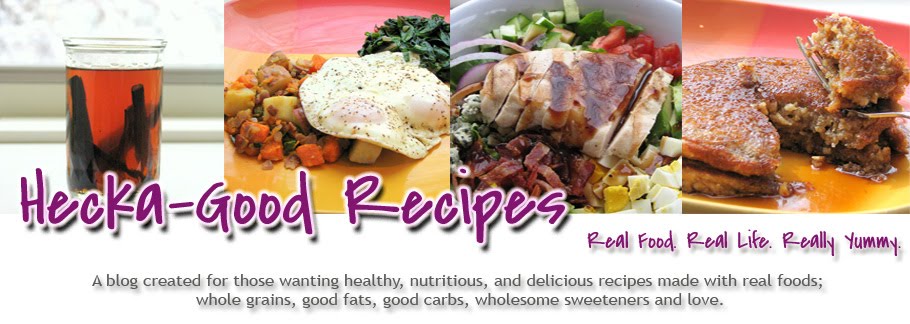Bear with me for a moment for a very technical, possibly boring, lesson. Don't worry, I'll get to the good stuff (the recipe) at the end! :)
A bit part of the
Eat Fat, Lose Fat diet is repairing your gut and replenishing the friendly bacteria. Today most people take probiotic supplements containing these healthy bacteria for the digestive tract. Traditional cultures did not take probiotics. They obtained these healthy bacteria from lacto-fermented foods such sauerkraut and other pickled vegetables and fruits. Sauerkraut is familiar to most of us. Cabbage is pounded and mixed with salt to encourage the growth of lactobacilli, a bacteria that produces lactic acid, which also acts as a preservative. Fermented dairy products, such as yogurt and kefir (a sour, fermented milk beverage), and other lacto-fermented beverages, also act as probiotics. In addition to these awesome probiotics, fermented foods and beverages also have loads of enzymes, a higher vitamin content and minerals that are more readily absorbed.
In the Health and Recovery phase of the Eat Fat, Lose Fat diet (and strongly encouraged in the Quick and Easy Weight Loss phases) you drink three lacto-fermented drinks per day. Soaking grains is one way of making lacto-fermented beverages. Some traditional cultures used (and still use) soaked corn or sorghum. A popular modern-day soaked grain lacto-fermented drink is called
Rejuvelac, which is made by soaking wheat. If you can tolerate wheat and gluten, this could be a great option for you.
Another method of making these healthy beverages is using kefir grains. Kefir grains are a not a "grain" like wheat or barley, but a grain, as in a grain of salt. These grains contain lactic acid bacteria and yeast, and when placed in a liquid at room temperature for a period of 12-48 hours create healthy lacto-fermented beverages. The grains use naturally occurring sugars in the liquids to feed off. Kefir grains cannot be produced from scratch, you will need to obtain grains from someone. If properly cared for, the grains last indefinitely and will grow, allowing you to share your grains with others. I will post Resources link where you can purchase your own grains at the end of this post.
There are two types of kefir grains; milk and water. As their name infers, milk kefir grains are used in milk. Traditionally cow or goat milk was used, but coconut and other nut milks can also be used. Water kefir grains are used in water (added sweetener needed), coconut water, or fruit juices.
 |
| My very happy, multiplying water kefir grains! |
The finished product is a tart, effervescent liquid that can be used in so many ways. Milk kefir thickens and is the consistency of a thin yogurt, but with far more probiotics and health benefits than regular yogurt. I have been using my milk grains in coconut milk and my water grains in coconut water. They all seem very happy and are growing like crazy.
Okay, enough of this...let's get to the recipe. One of my favorite ways to enjoy kefir is using coconut milk kefir to make a smoothie in the morning. So addicting! No worries, recipes will be coming soon. :) My second favorite way to enjoy kefir is with Kefir Soda. This soda is a healthy alternative to the deadly (in my opinion) sugar/artificial sweetener, caffeine, carbonation laden sodas that most children and adults live off of. I had some fresh blueberries just begging to be used, so I threw them into some coconut water kefir and let it ferment for another 24 hours and....Tada! Blueberry Kefir Soda. It tastes very similar to IZZE Natural Soda. It is refreshing, delicious and sooooo very healthy.
 |
| See the bubbly soda goodness?! |
*This recipe is linked to
Simply Lives Thursday and
Pennywise Platter Thursday.
Blueberry Kefir Soda
Makes approx. 2 quarts
Note: This recipe takes 2 days and requires some special equipment
Special Equipment:
- Glass
soda bottles with wire-held caps (you can use mason jars with lids, it just won't be as bubbly)
- Non-metal strainer with small holes (wire mesh small)
- Plastic funnel
Ingredients:
2 quarts coconut water or filtered water (if using water only, also add the 1/2 cup sugar from below instead of adding it with the blueberries)
3/4 cup water kefir grains
2 cups fresh blueberries, mashed with a fork
1/2 cup coconut palm sugar, Rapadura, or Sucanat
Method:
1. Place the grains in a large glass container and pour the coconut water over the them. Cover with a clean kitchen towel and leave at room temperature for 24 hours. Strain the liquid using a non-metal strainer into a large glass container, reserving the kefir grains to start another batch.
2. Using a funnel pour the water kefir into the soda bottle(s). Next add the blueberries and sugar. Close cap and shake the bottle a few times. Leave at room temperature for 24 hours, shaking occasionally.
3. Place the bottle inside a large mixing bowl (the overflow catcher). Place a clean washcloth over the bottle and open the cap. CAUTION: Contents under pressure WILL explode. (I learned this the hard way. I had blueberry soda all over my kitchen.) Once the craziness has settled strain the liquid into a medium bowl and discard the blueberry pulp. Strain any liquid in the large overflow catcher mixing bowl into the medium bowl. Using a funnel pour the liquid back into the soda bottle(s). Serve immediately over ice or chilled for several hours. Store in refrigerator for several days.
Kefir Grains Resources
I ordered my grains from:
Organic Raw Milk Kefir Grains from
One Great Place @ Etsy
Organic Water Kefir Grains from
Keysands @ Etsy
Other sources:
Cultures For Health (if you sign up for their free newsletter you get a free Kefir Recipe e-book)
Kefir Lady











